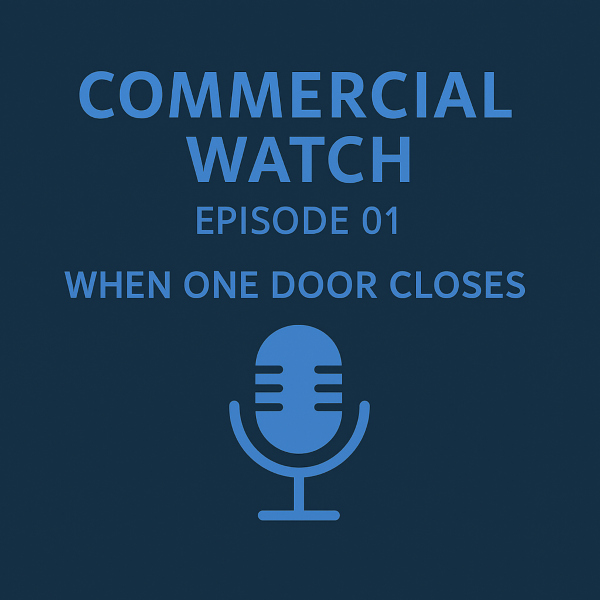Commercial Watch Episode 01 | Buy-to-Let Market Shifts & Opportunities. Welcome to the launch of our Commercial Watch series with Episode 1, where we spotlight key developments shaping the buy-to-let mortgage market. Recent shifts in tax relief, stamp duty, rental stress testing, and PRA rules for portfolio landlords have significantly reshaped the landscape.
As a result, many landlords are actively seeking alternative strategies to offset rising costs and tighter regulations. One clear trend is the increasing move toward commercial and semi-commercial (mixed-use) property investments, which offer potential solutions for experienced and portfolio landlords alike.

This growing interest in diversifying into commercial and specialist buy-to-let sectors reflects a broader response to market challenges. Not only can this strategy help ease regulatory pressure, but it may also lead to stronger long-term capital growth, especially as demand drives prices upward and reduces available stock in these niche sectors.
To explore how advisers can support clients with complex cases, visit our Specialist Mortgages for Clients With Complex Cases.
Rising Demand for Semi-Commercial Buy-to-Let Properties
The UK property market is seeing a notable rise in interest in semi-commercial buy-to-let investments, typically properties featuring a retail unit (such as a shop) with residential accommodation above. These hybrid assets combine the benefits of both residential and commercial buy-to-let, making them increasingly attractive to savvy landlords and investors.
An emerging trend shows shop owners actively seeking planning permission to convert upper floors into flats or, in some cases, fully redeveloping retail premises into residential housing. This shift aligns with traditional BTL landlords looking to diversify their portfolios with semi-commercial assets that offer both yield stability and growth potential.
Semi-commercial opportunities extend beyond shops. Properties above pubs, restaurants, hotels, garages, and even supermarkets are being converted into flats to address the UK’s housing shortage. Supermarket chains, in particular, are exploring airspace development by adding residential units above stores, an approach supported by many local councils due to its use of brownfield sites and contribution to housing targets.
For experienced buy-to-let borrowers, semi-commercial property presents a logical progression: retaining familiarity with residential elements while entering the commercial space with lower risk. Lenders are also increasingly favouring applicants who have demonstrated success in managing multi-unit or portfolio BTL properties, making this a strategic move for growth-focused landlords.
“Even supermarkets are exploring ways to build residential flats above their stores.”
Tax Advantages and Lower Costs in Commercial & Semi-Commercial Buy-to-Let
Commercial and semi-commercial properties offer distinct tax advantages for landlords, especially when compared to traditional buy-to-let structures.
Unlike residential BTL, commercial mortgage interest is fully deductible before tax calculations. This means landlords can offset all loan interest payments against their rental income. This benefit also applies proportionally to semi-commercial properties, creating a more tax-efficient structure for mixed-use investments.
In addition, stamp duty charges on commercial and semi-commercial purchases are significantly lower. For example, a £250,000 commercial property incurs just 2% stamp duty, compared to the 5% residential rate, plus an additional 3% second-property surcharge in many BTL cases.
Another major benefit is that commercial and semi-commercial investments are not subject to PRA stress testing rules. For portfolio landlords, this means commercial lenders may not assess background properties under stress tests, offering more borrowing flexibility than standard buy-to-let lenders.
With more financing options entering the market, including high-street banks, challenger banks, and specialist commercial lenders, advisers and landlords now have a broader pool of funding solutions tailored for complex buy-to-let and semi-commercial cases.
Need access to specialist lenders for semi-commercial or portfolio cases? Explore our Specialist Mortgage Network for Advisers for guidance and support.
Comparing High-Street and Specialist Buy-to-Let Lenders
When exploring commercial buy-to-let finance, advisers must weigh the pros and cons of high-street lenders versus specialist buy-to-let providers.
High-Street Commercial Mortgage Options
High-street lenders often offer competitive commercial mortgage rates, typically in the 3–4% range. However, these seemingly attractive deals come with limitations. Loan-to-value (LTV) ratios are usually capped at 60–65%, which can restrict borrowing power for many clients. In select cases, lenders may extend to 80% LTV for established trading businesses, but only under strict criteria.
Repayment terms are commonly structured around tenancy agreements, providing predictability for both borrower and lender. Additionally, many high-street banks require in-person meetings to fully assess the business case, ensuring a thorough review of the applicant’s financials and long-term viability.
While stable and cost-effective, these products may not suit clients with non-standard income, complex portfolios, or evolving commercial plans.
Understanding Commercial Property Lease Dynamics
Commercial property leases offer tailored space solutions for businesses, distinct from standard residential agreements. These leases typically span three to twenty years, providing long-term stability that supports business continuity and strategic expansion.
Key Lending Criteria for Commercial Buy-to-Let
Similar to buy-to-let lending, securing finance for commercial property depends on a combination of tenant strength, lease structure, and rental income. Lenders tend to be more flexible with established corporations, viewing them as lower risk than startups or small enterprises.
Why Tenant Profile Matters in Lending Decisions
The tenant’s financial credibility is a central factor in commercial mortgage approvals. Long-term leases with blue-chip tenants often result in more favourable terms, as lenders value stability and predictable rental flows. Strong tenant profiles reduce perceived risk and improve borrowing prospects.
Leasing Terms That Enable Growth
While a three-year lease may be the minimum, businesses often secure 10–20-year leases to ensure continuity and operational control. These extended terms help businesses invest in their premises, plan for the long term, and establish a solid footprint in competitive markets.
Financing Commercial Properties in the UK
When sourcing funding for commercial units, advisers and landlords must assess lease duration, tenant quality, and the strength of the rental agreement. These factors directly influence lender decisions and determine whether a case qualifies for commercial or super specialist buy-to-let lending.
For cases involving complex structures, limited company BTL, or semi-commercial units, many advisers choose to work with a Specialist Mortgage Network for Advisers or seek packaging support from a Buy-to-Let Mortgage Broker.
Thank you for reading our publication “Commercial Watch Episode 01 | When One Door Closes.” Stay “Connect“-ed for more updates soon

